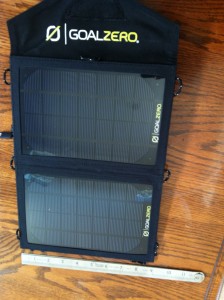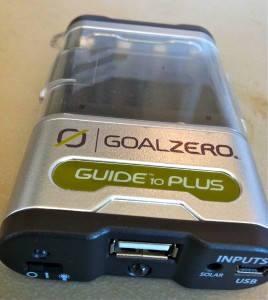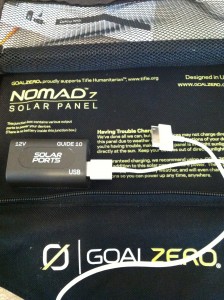Yesterday I took the first step into the solar power world. It was a small step, but for the first time I harnessed energy from the sun.
I did it with a Goal Zero Portable Solar Power Pack Kit that we bought from Costco. The kit came with a Nomad 7 Solar Panel and a Guide 10 Plus Battery Pack (also included: Luna LED light stick, 12V car adapter port, and a set each of AA and AAA rechargeable batteries) and cost about $100.
We all know “buying stuff is easy”; so it was time to get everything out, read the directions, and actually used it.
Both the Solar Panel and the Battery Pack appear to be solidly built with good construction and design; a nice zip pocket is built into the back of the Solar Panel that can carry all the accessories including the Battery Pack. Both products are stated, and appear, to be “weather-resistant.”
The Solar Panel can be used independently to charge devices; but it’s more efficiently used in conjunction with the Battery Pack.
Solar Panel
 The Nomad 7 Solar Panel is designed to be backpack portable (including being used, open and charging, attached to a pack while hiking). It folds up small: 9 inches wide x 6.5 inches long x 1 inch thick; open it is still small: 9 inches wide x 17 inches long x 0.1 inch thick, and weighs only 0.8 pounds. It’s rated at 7W with a monocrystalline cell type and a converting efficiency of 17-18%. Goal Zero states this “delivers more power per square inch than any other solar technology on the market.”
The Nomad 7 Solar Panel is designed to be backpack portable (including being used, open and charging, attached to a pack while hiking). It folds up small: 9 inches wide x 6.5 inches long x 1 inch thick; open it is still small: 9 inches wide x 17 inches long x 0.1 inch thick, and weighs only 0.8 pounds. It’s rated at 7W with a monocrystalline cell type and a converting efficiency of 17-18%. Goal Zero states this “delivers more power per square inch than any other solar technology on the market.”
Attached to the back of the Solar Panel is the Solar Ports junction box, with: a USB port, a Battery Pack port, and a 12V output port for a car charger adapter.
The Solar Panel’s directions are simple, essentially: open, angle toward the sun, then plug your device into the appropriate charging port. I plugged my iPhone 4 into the Solar Ports junction box USB port and positioned the panel toward the sun. The literature said it should charge a smart phone in 2 – 4 hours. My phone started at 50% battery capacity. At one hour it was at 85%, and it was fully charged at an hour and a half. So for my phone, with full sunlight, about 35% charge per hour — not bad at all.
The Solar Panel can charge “most hand-held USB devices, like: cell phone, smart phone, GPS, MP3 player, Goal Zero products”.
Battery Pack
 The Guide 10 Plus Battery Pack is designed to charge AA or AAA NiHM batteries (comes with a AAA adapter). The most efficient way to charge a smart phone is to plug the Battery Pack (with batteries in it) into the Solar Panel and then plug the phone into the USB port on the Battery Back. This way the batteries are charging the phone and the Solar Panel is charging the batteries. The device has a standard USB and a mini-USB port. It also has a small built-in LED flashlight that puts out “100+ hours of light per charge”; kind of a neat little bonus — not that you’d be setting up your Solar Panel in the dark, but it is designed for camping and an extra flashlight never hurts. And it’s easy to carry around at only 0.4 pounds (plus battery weight).
The Guide 10 Plus Battery Pack is designed to charge AA or AAA NiHM batteries (comes with a AAA adapter). The most efficient way to charge a smart phone is to plug the Battery Pack (with batteries in it) into the Solar Panel and then plug the phone into the USB port on the Battery Back. This way the batteries are charging the phone and the Solar Panel is charging the batteries. The device has a standard USB and a mini-USB port. It also has a small built-in LED flashlight that puts out “100+ hours of light per charge”; kind of a neat little bonus — not that you’d be setting up your Solar Panel in the dark, but it is designed for camping and an extra flashlight never hurts. And it’s easy to carry around at only 0.4 pounds (plus battery weight).
The Battery Pack holds four AA or AAA batteries. All four batteries must be charged at the same time, but not all batteries need to be empty (I believe this is standard with rechargeable batteries). The literature states “three hours expected charge times in good sun”; so I put discharged batteries in the charger, positioned the solar panel, and came back three hours later to fully charged batteries. Once you have charged batteries, the Battery Pack USB ports can be used to charge your devices without the Battery Pack being connected to the Solar Panel. So I then charged my iPhone from the (disconnected) Battery Pack without any issues. In summary, charge the batteries up when there is sun and use the energy stored in the batteries when needed.
Recommendation
It’s a pretty cool, compact, affordable system. It seems to work very well and couldn’t be much simpler. It looks rugged and practical enough that I wouldn’t hesitate to throw it in (or on) a pack and take it with me anywhere.
As a prepper–trying to be prepared in case of emergencies or disasters–communication is very important. Sure the cell network can go down, but if it’s up and available it’d suck if you couldn’t access it just because your phone’s battery is dead. This is a product that can help prevent that from happening.
I’d definitely recommend the Goal Zero Nomad 7 Solar Panel and Guide 10 Plus Battery Pack. Not only would it be great for hiking/camping, it would be a big asset to keep you more prepared in case of a disaster.
Here’s a short video by Goal Zero that shows their devices being used (I’ve discussed their small Battery Pack, they also have a medium and large Battery Pack that are shown in the video.)
http://www.youtube.com/watch?v=4-pgoafc_bk&feature=player_embedded
(Friday: What We Did This Week To Prep)


I’m taking steps as well into solar. I’m setting up for a solar backup for my home. So far I have 2 145watt panels and a charge controller. Tomorrow I’m ordering the inverter and getting started on batteries. My goal is to be able to run my fridge, router, and lights.
Good for you! Did you buy the 145W panels new or do you have a good source for used ones? If you live in the Western Washington area I may have a great source of deep cycle AMC batteries for you (I bought 4 from a local sources last year and just sent him an email to see if he still sells them).
Pingback: What We Did This Week To Prep | TraceMyPreps